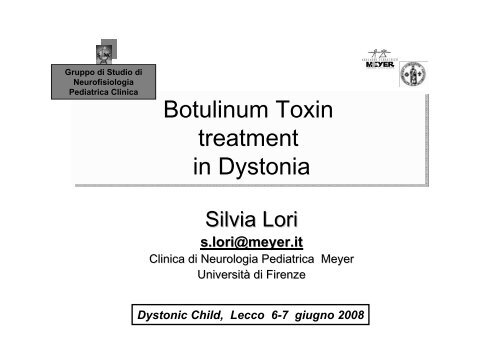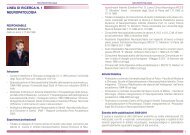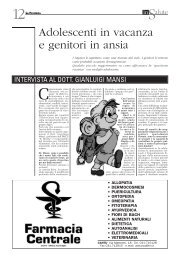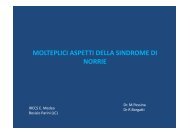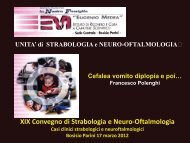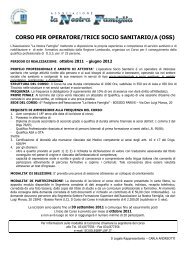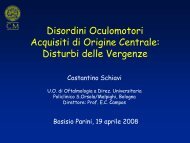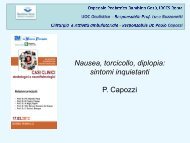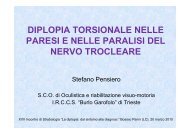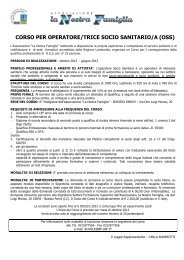Botulinum Toxin treatment in Dystonia
Botulinum Toxin treatment in Dystonia
Botulinum Toxin treatment in Dystonia
Create successful ePaper yourself
Turn your PDF publications into a flip-book with our unique Google optimized e-Paper software.
Gruppo di Studio di<br />
Neurofisiologia<br />
Pediatrica Cl<strong>in</strong>ica<br />
<strong>Botul<strong>in</strong>um</strong> <strong>Tox<strong>in</strong></strong><br />
<strong>treatment</strong><br />
<strong>in</strong> <strong>Dystonia</strong><br />
Silvia Lori<br />
s.lori@meyer.it<br />
Cl<strong>in</strong>ica di Neurologia Pediatrica Meyer<br />
Università di Firenze<br />
Dystonic Child, Lecco 6-7 giugno 2008
Background<br />
• <strong>Dystonia</strong>,<br />
def<strong>in</strong>ed as “a neurological syndrome characterised by <strong>in</strong>voluntary<br />
patterned, susta<strong>in</strong>ed, or repetitive muscle contractions of oppos<strong>in</strong>g<br />
muscles,caus<strong>in</strong>g twist<strong>in</strong>g movements and abnormal postures “.<br />
(Fahn, Bressman & Marsden, 1998)<br />
• Is one of the most disabl<strong>in</strong>g movement disorders.<br />
• Although pathogenesis-targeted <strong>treatment</strong> is still elusive, the currently<br />
available symptomatic <strong>treatment</strong> strategies are quite effective for some<br />
types of dystonia <strong>in</strong>:<br />
reliev<strong>in</strong>g <strong>in</strong>voluntary movements,<br />
correct<strong>in</strong>g abnormal posture,<br />
prevent<strong>in</strong>g contractures,<br />
reduc<strong>in</strong>g pa<strong>in</strong>,<br />
improv<strong>in</strong>g function and quality of life
Distonia <strong>treatment</strong>
Rationale to use <strong>Botul<strong>in</strong>um</strong> <strong>Tox<strong>in</strong></strong><br />
• Neuromuscular blockade via <strong>in</strong>jection of botul<strong>in</strong>um<br />
tox<strong>in</strong> reduces the tone of overactive muscles <strong>in</strong> order<br />
to restore the appropriate balance between agonists<br />
and antagonists<br />
<strong>Botul<strong>in</strong>um</strong> <strong>Tox<strong>in</strong></strong> (BTX), purified forms of<br />
Clostridium botul<strong>in</strong>um exotox<strong>in</strong>s:<br />
Seven Serotype<br />
Human Botulism<br />
A B C D<br />
E F G
Mechanism of Action<br />
BTX are <strong>in</strong>jected directly <strong>in</strong>to<br />
muscle, where they cleave one<br />
or more vesicle fusion prote<strong>in</strong>s,<br />
thus block<strong>in</strong>g release of<br />
acetylchol<strong>in</strong>e at the<br />
neuromuscular junction.<br />
B, D, F, G<br />
A, C, E
•Levels of Action<br />
• Alpha Motor end<strong>in</strong>g<br />
• Gamma Motor end<strong>in</strong>g<br />
• Chol<strong>in</strong>ergic Autonomic end<strong>in</strong>g<br />
• Central Nervous System
BTX has a cl<strong>in</strong>ical onset of action<br />
approximately 12 to 72 hours after<br />
<strong>in</strong>jection, with a peak effect at 1 to 3<br />
weeks.<br />
Effects then plateau for 1 to 2 months<br />
“sprout<strong>in</strong>g”<br />
“tim<strong>in</strong>g<br />
recovery”<br />
Neuromuscular function: 3-5 month<br />
Autonomic function: > 5 month<br />
…”snare<br />
snare” prote<strong>in</strong> disattivation
Mur<strong>in</strong>e Endplate Response to Intramuscular BoNT-A<br />
Sprout<strong>in</strong>g<br />
Recovery<br />
Source: dePaiva et al. PNAS 1999, 96:3200
Four commercial products :<br />
three of serotype A<br />
Botox® 100 U<br />
Dysport® 500 U<br />
Necessary diluition<br />
Xeom<strong>in</strong>®100U…..<br />
and one serotype B<br />
Neurobloc® 5000-10000 U<br />
Each differs <strong>in</strong> its unit potency, duration of action and side effects<br />
Side effects may <strong>in</strong>clude local discomfort at the site of the <strong>in</strong>jection<br />
and excessive weakness of the <strong>in</strong>jected or nearby muscles
Botox ®<br />
(1989)<br />
Neurobloc <br />
(2000)<br />
Dysport ®<br />
(1991)<br />
serotype / target<br />
BoNT/A<br />
SNAP-25<br />
BoNT/B<br />
VAMP<br />
BoNT/A<br />
SNAP-25<br />
Molec.weight (kD)<br />
900 kDa 700 kDa # 500 kDa<br />
excipients<br />
NaCl<br />
Sero-album<strong>in</strong><br />
NaCl<br />
Sero-album<strong>in</strong><br />
Succ<strong>in</strong>ate Na<br />
Lactose<br />
sero-album<strong>in</strong><br />
F<strong>in</strong>al Formulation<br />
unit/vial<br />
Prote<strong>in</strong>/vial<br />
Dried vacuumpacked<br />
pH: ~7<br />
100U<br />
~5ng<br />
Solution<br />
pH: 5.6<br />
5000, 10,000<br />
50/100ng<br />
Lyophilized<br />
pH: ~7<br />
500U<br />
12.5ng<br />
#Elan PI data states as 700kDa; literature reports largest complex for B is 500 kDa and largest complex for A is 900 kDa
•Procedure<br />
to treat:<br />
• Sett<strong>in</strong>g care<br />
• Target selection:<br />
Muscle ispection;<br />
video-analysis,<br />
gait-analysis;<br />
Ultrasound;<br />
CT/MR;<br />
EMG<br />
500µV<br />
DELTOID<br />
BIC.BRACH<br />
Recommendations:<br />
Parents<br />
<strong>in</strong>formation<br />
consensus<br />
BTX choise/diluition/dose<br />
TRIC.BRACH<br />
Consensus dos<strong>in</strong>g guidel<strong>in</strong>es<br />
• No-pa<strong>in</strong><br />
Needle<br />
• Ice pre-post<br />
post <strong>in</strong>jection<br />
(anesthesia,, >diffusion><br />
diffusion)<br />
10s<br />
Accurate selection of muscle<br />
Re-<strong>in</strong>jection > 4 month
failure – no responder<br />
• Error of muscle(s) evaluation<br />
• Error of BTX preparation and/or conservation<br />
• Jo<strong>in</strong>ts structuration<br />
• Antibody formation aga<strong>in</strong>st BTX<br />
Switch<strong>in</strong>g serotypes may be effective, at least temporarily.<br />
For better response may to use<br />
more serotype of BTX
BTX <strong>in</strong> <strong>Dystonia</strong><br />
Elective to treat Focal <strong>Dystonia</strong> (little muscles):<br />
blepharospasmus, spasmodic dystonia (torticollis..).<br />
Good/partial/variable results <strong>in</strong> Segmental <strong>Dystonia</strong>,<br />
because localisation, number and muscles size<br />
(limb dystonia)<br />
“Add-on” <strong>in</strong> Generalized <strong>Dystonia</strong>
Treatment of dystonia.<br />
Jankovic J. Lancet Neurol. 2006 Oct;5(10):864-72<br />
Therapeutic options must be tailored<br />
Therapeutic options must be tailored to the needs of<br />
<strong>in</strong>dividual patients and <strong>in</strong>clude chemodenervation with BTX<br />
<strong>in</strong>jections for patients with focal or segmental dystonia, and<br />
medical <strong>treatment</strong>s or deep bra<strong>in</strong> stimulation for patients<br />
with generalised dystonia.
Treatment of recalcitrant idiopathic muscular torticollis <strong>in</strong> <strong>in</strong>fants<br />
with botul<strong>in</strong>um tox<strong>in</strong> type a. a<br />
Joyce MB, J Craniofac Surg. 2005 Mar;16(2):321-7.<br />
<strong>Botul<strong>in</strong>um</strong> tox<strong>in</strong> type a <strong>in</strong> the <strong>treatment</strong> of children with congenital<br />
muscular torticollis.<br />
Oleszek JL,. Am J Phys Med Rehabil. 2005 Oct;84(10):813-6<br />
<strong>Botul<strong>in</strong>um</strong> tox<strong>in</strong> <strong>in</strong>jection for congenital muscular torticollis present<strong>in</strong>g <strong>in</strong><br />
children and adults.<br />
Coll<strong>in</strong>s A,. Neurology. 2006 Sep 26;67(6):1083-5<br />
BTXA may be a safe and effective <strong>treatment</strong> option for children with<br />
congenital muscular torticollis who are unresponsive to only traditional<br />
regimen of physical therapy and a home program.<br />
It may obviate the need for surgical release of a tight non fibrotic SCM
Distonia<br />
“There is a caudo-cranial<br />
cranial<br />
gradient <strong>in</strong> age of onset and<br />
the age of onset <strong>in</strong>creases as<br />
the cranial presentation<br />
becomes greater”<br />
Bartolomé 2003<br />
Fahn 1988
Genetica<br />
Locus Cl<strong>in</strong>ical Features Inheritance Location Gene Product<br />
DYT1 Early-onset<br />
AD 9q34 Tors<strong>in</strong> A<br />
DYT2<br />
Generalized<br />
Early-onset Segmental AR ? ---<br />
DYT3<br />
(Generalized)<br />
Generalized-Segmental XR Xq13.1 ---<br />
+ Park<strong>in</strong>sonism<br />
DYT4 Dysphonia AD -- ---<br />
DYT5 Dopa Responsive AD 14q22.1-2 GTP<br />
cyclohydrolase1<br />
<strong>Dystonia</strong>-Park<strong>in</strong>sonism AR 11p15.5 Tyros<strong>in</strong>-<br />
Hydroxilase<br />
DYT6 Adolescent Segmental AD 8p21-22 ---<br />
DYT7 Adult Focal AD 18p ---<br />
DYT8 Paroxysmal choreoathetosis AD 2q33-35 ---<br />
DYT9 Paroxysmal choreoathetosis AD 16p11.2 ---<br />
+ ataxia, spasticity<br />
DYT10 Paroxysmal k<strong>in</strong>esigenic AD 16p11.2 ---<br />
choreoathetosis<br />
DYT11 Myoclonus-dystonia +<br />
park<strong>in</strong>sonism<br />
AD 11q23 ε-sarcoglycan<br />
(D2 receptor)<br />
DYT12 Rapid-onset dystonia + AD 19q ---<br />
park<strong>in</strong>sonism<br />
DYT13 Juvenile or early adult<br />
Segmental (Cranio-cervical)<br />
AD 1p36 --<br />
BTX
Dystonic Syndromes<br />
BTX <strong>treatment</strong> ?!<br />
Lesion<br />
Cerebral Palsy
<strong>Dystonia</strong>: : an update on genetics and <strong>treatment</strong><br />
Misbahudd<strong>in</strong> A Curr Op<strong>in</strong> Neurol. 2001 Aug;14(4):471-5<br />
Treatment of more severe dystonia has been a difficult area, with only limited success from<br />
medical therapies.<br />
<strong>Botul<strong>in</strong>um</strong> tox<strong>in</strong> type A <strong>treatment</strong> <strong>in</strong> neurogenetic syndromes<br />
Pidcock FS , Pediatr Rehabil. 2005 Oct-Dec;8(4):298-302<br />
The use of BTX-A <strong>in</strong> uncommon neurogenetic syndromes was supported by the majority<br />
of families <strong>in</strong>terviewed.<br />
Management of movement disorders <strong>in</strong> glutaryl-CoA<br />
dehydrogenase<br />
deficiency: antichol<strong>in</strong>ergic drugs and botul<strong>in</strong>um tox<strong>in</strong> as additional<br />
therapeutic options<br />
Burl<strong>in</strong>a AP, J Inherit Metab Dis. 2004;27(6):911-5<br />
BTX-A <strong>in</strong> add-on with antichol<strong>in</strong>ergic drugs<br />
<strong>Botul<strong>in</strong>um</strong> tox<strong>in</strong> as a novel <strong>treatment</strong> for self-mutilation <strong>in</strong> Lesch-Nyhan<br />
syndrome.<br />
Dabrowski E Dev Med Child Neurol. 2005 Sep;47(9):636-9.<br />
<strong>treatment</strong> with BTX-A affects both the central and peripheral nervous systems,<br />
result<strong>in</strong>g <strong>in</strong> reduced self-abusive behavior <strong>in</strong> this patient.
<strong>Botul<strong>in</strong>um</strong> tox<strong>in</strong> as a <strong>treatment</strong> for <strong>in</strong>fantile cerebral palsy<br />
Pascual-Pascual SI, Rev Neurol. 1997 Sep;25(145):1369-75<br />
BTA is highly effective <strong>in</strong> the <strong>treatment</strong> of spastic and/or dystonic CP, and if<br />
associate with physiotherapy long and even permanent effect can be achieved<br />
Preoperative <strong>treatment</strong> with botul<strong>in</strong>um tox<strong>in</strong> to facilitate cervical fusion <strong>in</strong><br />
dystonic cerebral palsy. Report of two cases.<br />
Racette BA J Neurosurg. 1998 Feb;88(2):328-30.<br />
Preoperative chemodenervation of selected cervical muscles with <strong>in</strong>jections of high-dose<br />
BTX-A A elim<strong>in</strong>ated all <strong>in</strong>voluntary neck movements, permitt<strong>in</strong>g the patients to tolerate halo<br />
fixation and facilitat<strong>in</strong>g postoperative sp<strong>in</strong>al fusion.<br />
Injectable neuromuscular blockade <strong>in</strong> the <strong>treatment</strong> of spasticity and<br />
movement disorders<br />
Tilton AH. J Child Neurol. 2003 Sep;18 Suppl 1:S50-66<br />
The <strong>treatment</strong> program, <strong>in</strong> which chemodenervation is only one tool, requires a<br />
multidiscipl<strong>in</strong>ary evaluation and <strong>in</strong>dividualized plan to address the whole patient.<br />
<strong>Botul<strong>in</strong>um</strong> tox<strong>in</strong> type B improves the speed of reach<strong>in</strong>g <strong>in</strong> children with<br />
cerebral palsy and arm dystonia: : an open-label, dose-escalation escalation pilot study.<br />
Sanger TD, J Child Neurol. 2007 Jan;22(1):116-22.<br />
Use of BTX-B as a safe and effective <strong>treatment</strong> for upper extremity dystonia <strong>in</strong> children<br />
with cerebral palsy. Larger controlled trials are needed to confirm these results
Meyer: pz 2004-2007<br />
2007<br />
59 CP pz (29F-30M)<br />
13 CP Dystonic<br />
46 CP Spastic<br />
22%<br />
56 pz treated with BTX-A<br />
78%<br />
5 SUP/INF LIMB<br />
2 SUP LIMB<br />
49 INF LIMB<br />
Follow-up<br />
up: : 1-3-6-121<br />
12 month after <strong>treatment</strong>
54/59 pz<br />
4<br />
4<br />
Ashworth Mean/month<br />
Ashworth Mean/month<br />
120<br />
120<br />
100<br />
100<br />
80<br />
80<br />
ROM mean/month<br />
ROM mean/month<br />
3<br />
3<br />
ROM ATTIVO GIN. FLESSO<br />
ROM ATTIVO GIN. FLESSO<br />
ROM ATTIVO GIN.ESTESO<br />
ROM ATTIVO GIN.ESTESO<br />
ROM PASSIVO GIN FLESSO<br />
ROM PASSIVO GIN FLESSO<br />
ROM PASSIVO 2 GIN ESTESO<br />
ROM PASSIVO 2 GIN ESTESO<br />
60<br />
60<br />
1<br />
1<br />
40<br />
40<br />
20<br />
20<br />
0<br />
0<br />
ASH pre ASH 1 ASH 3 ASH 6 ASH 12<br />
ASH pre ASH 1 ASH 3 ASH 6 ASH 12<br />
0<br />
Quality <strong>treatment</strong> for family<br />
60<br />
50<br />
40<br />
Parents<br />
30<br />
20<br />
10<br />
0<br />
0<br />
Pre 1 3 6 12<br />
1 2 3 4 5<br />
1 2 3 4 5<br />
1 2 3<br />
1 <strong>in</strong>satisfactory<br />
2 sufficient<br />
3 good<br />
13/59 pz<br />
BAD Scale: se<br />
16<br />
16<br />
BAD Scale: segmental mean<br />
BAD<br />
score<br />
Scale: se<br />
BAD Scale: segmental 3,5 mean score<br />
3,5<br />
3<br />
3<br />
4 3,46<br />
2,5<br />
4<br />
2,5 2<br />
2<br />
3<br />
2,30 1,5<br />
3<br />
1,5 1<br />
2<br />
1<br />
SUPINAZI 0,5<br />
2<br />
SUPINAZI 0,5 1,16<br />
55 0 65 70<br />
55 0 65 70<br />
10<br />
1<br />
10<br />
1<br />
-10<br />
pre<br />
-10<br />
pre -5<br />
post<br />
-5<br />
post<br />
55 5 20<br />
550<br />
5 20<br />
0 pre post var<br />
05 pre post var 60 65<br />
05 60 65
BTX and Central Nervous System
Breakdown of <strong>in</strong>hibitory mechanisms <strong>in</strong> dystonia<br />
Motor and SMA cortex<br />
Cortex<br />
Talamus<br />
Sp<strong>in</strong>al cord<br />
Ridd<strong>in</strong>g et al. 1995<br />
Sp<strong>in</strong>al Cord<br />
Bra<strong>in</strong>stem<br />
Nakashima et al. 1989<br />
Berardelli et al. 1995
Neurophysiology and control mechamisms:<br />
H Reflex<br />
TMS<br />
Sp<strong>in</strong>al cord<br />
BR<br />
Bra<strong>in</strong>stem<br />
LLR<br />
TMS<br />
Cortex
Conclusion<br />
BTX is a good tool for:<br />
reliev<strong>in</strong>g <strong>in</strong>voluntary movements,<br />
correct<strong>in</strong>g abnormal posture,<br />
prevent<strong>in</strong>g contractures,<br />
reduc<strong>in</strong>g pa<strong>in</strong>,<br />
Alone <strong>in</strong><br />
focal-segmental<br />
dystonia<br />
Add-on<br />
<strong>in</strong><br />
segmental or generalized<br />
dystonia<br />
improv<strong>in</strong>g function and quality of life<br />
BTX and central effects is a “challenge” for the<br />
therapeutic implications
Tnfp Katiuscia Romano<br />
FT Monica Mart<strong>in</strong>i<br />
FT Silvia Paoli<br />
Thank


